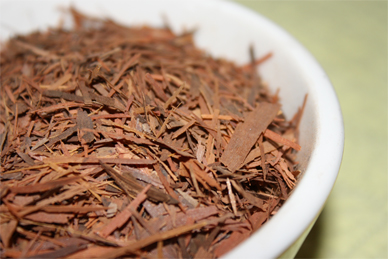Pau D’Arco makes a delicately scented, mild tea but it’s chemical properties that act against cancer are anything but mild and delicate.
Pau D’Arco is a tree, growing in the southern rain forests of Brazil and Argentina. Pau D’Arco contains active quinone compounds which have been studied extensively for their potential use in pharmaceutical agents for cancer treatment.
Native healers have used the inner bark of this tree for thousands of years to inhibit and slow the growth of cancers and tumors. It was reportedly used in “South American hospitals and clinics to treat leukemia … Dr. Theodore Meyer of Argentina reported five leukemia victims were completely cured of cancer by Pau D’Arco” (Tierra, 1998).
Pau D’Arco has many names; Tabebuia Impetiginosa, Tabebuia Heptaphylla Lapachol, Purple Lapachol, Tabebuia, and Taheebo.
Notice the anticancer properties of LAPACHOL Bark:
“Antiabscess; Antibacterial; Anticarcinomic 100-400 ppm; Antiedemic; Antiinflammatory; Antimalarial; Antiseptic; Antitumor; Antiviral; Fungicide; Immunostimulant 0.01 mg/ml; Insectifuge; Pesticide; Protisticide; Respiradepressant; Schistosomicide; Termiticide. Pau D’Arco also has potent anti-fungal, anticancer, antidiabetic, bitter tonic, digestive, antibacterial and anti-tumor properties (Duke, 2009).”
Pau D’Arco has alterative properties that work to deeply and gently cleanse our blood, remove toxins and stimulate white blood cell production. Alteratives are best used consistently for a period of weeks or months. Start slowly, especially if you are debilitated by illness and gently increase the dose over one to two weeks. Alteratives can cause systemic toxicity if the amount of acids and wastes released into your bloodstream are too much for your eliminatory system. This can overburden your liver, skin, bowels, lungs and kidneys and cause unnecessary symptoms of detoxification. Go slowly and consistently to reap the general detoxifying action of Pau D’Arco.
It has been used in fungal infections, cancer, to slow and inhibit tumor growth and to eliminate skin diseases.
In The Green Pharmacy Dr. Duke reports that Lapachol bark contains lapachol, beta-lapachone and xyloidine, three compounds which show activity against Candida Albicans and other common pathogenic fungi (Duke, 1997).
Like many other herbs, Pau D’Arco can have harmful effects when used in large amounts. In small quantities Pau D’Arco stimulates immune function, but in large doses it can have the opposite affect of suppressing immunity. More is not always better.
Alteratives are used slowly and consistently, in small quantities. One teaspoon to a cup of water, just off the boil, let steep for five to ten minutes.
Because of the strong anti-fungal properties of Pau D’Arco, it makes a useful remedy for yeast infections, eczema and psoriasis. To make a compress, soak a cloth in Pau D’Arco tea and lay on the infection, or pour a small amount of tea directly on the affected area, once or twice daily.
Warnings:
Always be aware of the active properties of the herbs you are using, especially if you are on medications or have a preexisting condition such as high blood pressure, liver or kidney disease, or if you are pregnant or nursing. Please always consult a qualified practitioner for more information.
In large amounts, Pau D’Arco can inhibit blood clotting. Consult a physician if you have heart disease, use blood thinners, or anticoagulants.
Pregnant and nursing women should never consume Pau D’Arco. It contains toxic quinines with Abortifacient activities.
References:
Dr. Duke’s Ethnobotanical and Phytochemical Database. (2010) Accessed October 3, 2010 from https://phytochem.nal.usda.gov/phytochem/search
Duke, Ph.D., James, A. (1997) The Green Pharmacy. Pennsylvania, U.S.A.: Rodale Press.
Tierra, L.Ac., O.M.D., Michael. (1998) The Way Of Herbs. New York, U.S.A.: Pocket Books, Simon & Schuster Inc.








Does anyone know a reputable website where I can order Pau D’arco? My father has stage 4 metastatic liver & lung cancer. I’m desperate….
I had a 7 pound 3 ounce tumor on my liver the doctor told me to go home and that I was going to die there was no hope ! another doctor took the tumor out but i still had to go for chemotherapy. I took 2 treatments and could not take another one, a friend of mine told me about the pau d arco tea. I used it, drank it every day , and began to feel better my strength came back,and 3 months later had to under go a ct scan. The doctor asked how the treatments were I told him that I only took 2 and he said the cancer was probably back after the tests, he came back shaking his head he said there was no sign of the cancer anywhere!!!!! It works I tell everyone to use it!!!!!
Dear Chris,
Thank you so much for sharing your experience with Pau D’Arco and liver cancer!! It’s so great to hear how well you are doing!! I truly believe Pau D’Arco is a powerful medicine too :)!!
Wonderful news!! That’s a tiny dog. I would be very careful and only give my dog very small amounts of medicinal herbs. They react much the same as we do however some herbs can have different effects on dogs. Keep a very close eye on her as you help her heal. Great idea to mix with slippery elm and chlorophyll – these also are incredibly healing and slippery elm will give her much relief I would bet. Thanks so much for sharing your experience! Lisa
Thank you for this excellent article. I have started giving this to my dog mixed with slippery elm and chlorophyll for cancer. In 2 days it appears to have healed a bladder infection (hadn’t show up on tests), which had been determined to be CRF by vet. This is phenomenal because for the past yr my dog has woke me up 2-3x/night for potty and now sleeps all through he night- no accidents. I have no doubt it will shrink her tumors – it is powerful stuff.I am winging it right now – if you have any recommendations for dosage for 11 lb dog plse email me. Once again thank you so much.